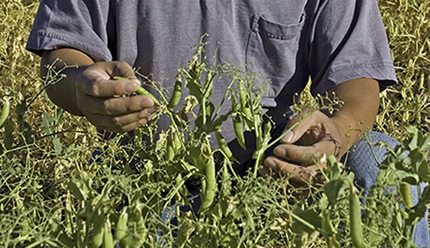Farmers in Montana, and other parts of the Northern Great Plains, are shifting from cereal mono-cropping to a cereal-dry pea cropping system; however, this transition is not without its share of unknowns.
Yield and performance of pea crops depend on their genetics and the environment. Environmental factors such as temperature and rainfall can vary greatly. Farmers in different parts of the Plains need to know which pea varieties will do well in the area they are farming.
Chengci Chen of Montana State University is working to generate that information. He has been studying how pea genetics interact with the environment to affect crop yields, and pea protein and starch content.
“Ultimately, I hope to be able to recommend which pea varieties to cultivate to growers in various environments,” says Chen.
To do that, Chen and his colleagues tested how nine different varieties of pea performed when grown in five locations across Montana. These locations were spread across the state and had different soils and climatic conditions.
Chen examined yield and protein and starch content of the different pea varieties. “These are characteristics that are important to growers and end users,” he says. Pea varieties that have higher yield can bring more profits to producers. Varieties that have higher protein or starch contents interest different end users.
For example, “dry yellow peas are fractionated into protein, starch and fiber. These components are widely used in food ingredients, especially by health-food businesses,” Chen explains. “The market for pea protein is growing rapidly because it is non-dairy and allergen-friendly.”
When the researchers evaluated the nine pea varieties grown in different environments, they found that “pea yield is affected by both genetics and environment, but environment has the larger effect,” Chen says.
Pea protein content is largely affected by environment as well. However, one kind of starch — resistant starch — content is mainly controlled by genetics.
Farmers in Montana, and other parts of the Northern Great Plains, are shifting from cereal mono-cropping to a cereal-dry pea cropping system; however, this transition is not without its share of unknowns.
Yield and performance of pea crops depend on their genetics and the environment. Environmental factors such as temperature and rainfall can vary greatly. Farmers in different parts of the Plains need to know which pea varieties will do well in the area they are farming.
Chengci Chen of Montana State University is working to generate that information. He has been studying how pea genetics interact with the environment to affect crop yields, and pea protein and starch content.
“Ultimately, I hope to be able to recommend which pea varieties to cultivate to growers in various environments,” says Chen.
To do that, Chen and his colleagues tested how nine different varieties of pea performed when grown in five locations across Montana. These locations were spread across the state and had different soils and climatic conditions.
Chen examined yield and protein and starch content of the different pea varieties. “These are characteristics that are important to growers and end users,” he says. Pea varieties that have higher yield can bring more profits to producers. Varieties that have higher protein or starch contents interest different end users.
For example, “dry yellow peas are fractionated into protein, starch and fiber. These components are widely used in food ingredients, especially by health-food businesses,” Chen explains. “The market for pea protein is growing rapidly because it is non-dairy and allergen-friendly.”
When the researchers evaluated the nine pea varieties grown in different environments, they found that “pea yield is affected by both genetics and environment, but environment has the larger effect,” Chen says.
Pea protein content is largely affected by environment as well. However, one kind of starch — resistant starch — content is mainly controlled by genetics.
Source: Seed World






